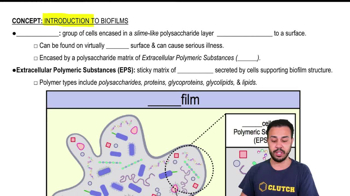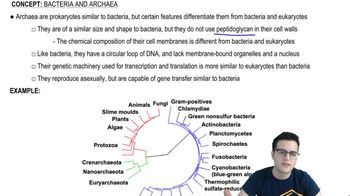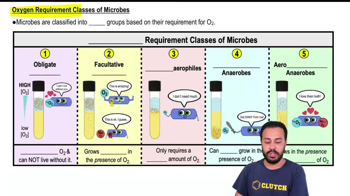Table of contents
- 1. Introduction to Biology2h 42m
- 2. Chemistry3h 40m
- 3. Water1h 26m
- 4. Biomolecules2h 23m
- 5. Cell Components2h 26m
- 6. The Membrane2h 31m
- 7. Energy and Metabolism2h 0m
- 8. Respiration2h 40m
- 9. Photosynthesis2h 49m
- 10. Cell Signaling59m
- 11. Cell Division2h 47m
- 12. Meiosis2h 0m
- 13. Mendelian Genetics4h 44m
- Introduction to Mendel's Experiments7m
- Genotype vs. Phenotype17m
- Punnett Squares13m
- Mendel's Experiments26m
- Mendel's Laws18m
- Monohybrid Crosses19m
- Test Crosses14m
- Dihybrid Crosses20m
- Punnett Square Probability26m
- Incomplete Dominance vs. Codominance20m
- Epistasis7m
- Non-Mendelian Genetics12m
- Pedigrees6m
- Autosomal Inheritance21m
- Sex-Linked Inheritance43m
- X-Inactivation9m
- 14. DNA Synthesis2h 27m
- 15. Gene Expression3h 20m
- 16. Regulation of Expression3h 31m
- Introduction to Regulation of Gene Expression13m
- Prokaryotic Gene Regulation via Operons27m
- The Lac Operon21m
- Glucose's Impact on Lac Operon25m
- The Trp Operon20m
- Review of the Lac Operon & Trp Operon11m
- Introduction to Eukaryotic Gene Regulation9m
- Eukaryotic Chromatin Modifications16m
- Eukaryotic Transcriptional Control22m
- Eukaryotic Post-Transcriptional Regulation28m
- Eukaryotic Post-Translational Regulation13m
- 17. Viruses37m
- 18. Biotechnology2h 58m
- 19. Genomics17m
- 20. Development1h 5m
- 21. Evolution3h 1m
- 22. Evolution of Populations3h 52m
- 23. Speciation1h 37m
- 24. History of Life on Earth2h 6m
- 25. Phylogeny2h 31m
- 26. Prokaryotes4h 59m
- 27. Protists1h 12m
- 28. Plants1h 22m
- 29. Fungi36m
- 30. Overview of Animals34m
- 31. Invertebrates1h 2m
- 32. Vertebrates50m
- 33. Plant Anatomy1h 3m
- 34. Vascular Plant Transport1h 2m
- 35. Soil37m
- 36. Plant Reproduction47m
- 37. Plant Sensation and Response1h 9m
- 38. Animal Form and Function1h 19m
- 39. Digestive System1h 10m
- 40. Circulatory System1h 57m
- 41. Immune System1h 12m
- 42. Osmoregulation and Excretion50m
- 43. Endocrine System1h 4m
- 44. Animal Reproduction1h 2m
- 45. Nervous System1h 55m
- 46. Sensory Systems46m
- 47. Muscle Systems23m
- 48. Ecology3h 11m
- Introduction to Ecology20m
- Biogeography14m
- Earth's Climate Patterns50m
- Introduction to Terrestrial Biomes10m
- Terrestrial Biomes: Near Equator13m
- Terrestrial Biomes: Temperate Regions10m
- Terrestrial Biomes: Northern Regions15m
- Introduction to Aquatic Biomes27m
- Freshwater Aquatic Biomes14m
- Marine Aquatic Biomes13m
- 49. Animal Behavior28m
- 50. Population Ecology3h 41m
- Introduction to Population Ecology28m
- Population Sampling Methods23m
- Life History12m
- Population Demography17m
- Factors Limiting Population Growth14m
- Introduction to Population Growth Models22m
- Linear Population Growth6m
- Exponential Population Growth29m
- Logistic Population Growth32m
- r/K Selection10m
- The Human Population22m
- 51. Community Ecology2h 46m
- Introduction to Community Ecology2m
- Introduction to Community Interactions9m
- Community Interactions: Competition (-/-)38m
- Community Interactions: Exploitation (+/-)23m
- Community Interactions: Mutualism (+/+) & Commensalism (+/0)9m
- Community Structure35m
- Community Dynamics26m
- Geographic Impact on Communities21m
- 52. Ecosystems2h 36m
- 53. Conservation Biology24m
26. Prokaryotes
Prokaryotic Metabolism
Problem 4`
Textbook Question
Which of the following involves metabolic cooperation among prokaryotic cells?
a. Binary fission
b. Endospore formation
c. Biofilms
d. Photoautotrophy
 Verified step by step guidance
Verified step by step guidance1
Understand the concept of metabolic cooperation: Metabolic cooperation refers to the interaction between different cells to achieve a metabolic process that benefits the community of cells.
Review the options: a. binary fission, b. endospore formation, c. biofilms, d. photoautotrophy.
Analyze each option: Binary fission is a form of asexual reproduction, endospore formation is a survival mechanism, biofilms are communities of microorganisms, and photoautotrophy is a mode of nutrition.
Focus on biofilms: Biofilms are structured communities of prokaryotic cells that adhere to surfaces and are embedded in a self-produced extracellular matrix. These communities often involve metabolic cooperation among the cells.
Conclude that biofilms (option c) involve metabolic cooperation, as the cells within a biofilm can share resources and metabolic products, enhancing their survival and efficiency.
 Verified video answer for a similar problem:
Verified video answer for a similar problem:This video solution was recommended by our tutors as helpful for the problem above
Video duration:
2mPlay a video:
Was this helpful?
Key Concepts
Here are the essential concepts you must grasp in order to answer the question correctly.
Metabolic Cooperation
Metabolic cooperation refers to the interaction between different cells or organisms to optimize metabolic processes. In prokaryotes, this often involves the sharing of resources or division of labor, where different cells perform different metabolic functions that benefit the community as a whole. This cooperation can enhance survival and efficiency in various environments.
Recommended video:
Guided course

Metabolic Rate
Biofilms
Biofilms are structured communities of microorganisms that adhere to surfaces and are embedded in a self-produced extracellular matrix. This matrix facilitates metabolic cooperation among the cells, allowing them to share nutrients, protect against environmental stresses, and resist antimicrobial agents. Biofilms are common in natural, industrial, and clinical settings, illustrating a key example of metabolic cooperation.
Recommended video:
Guided course

Introduction to Biofilms
Prokaryotic Cell Interactions
Prokaryotic cell interactions involve various forms of communication and cooperation among bacterial cells. These interactions can include quorum sensing, where cells communicate through chemical signals to coordinate behavior, and syntrophy, where different species exchange metabolic products. Such interactions are crucial for forming complex communities like biofilms, where metabolic cooperation is essential for survival and function.
Recommended video:
Guided course

Prokaryotic Cell Structures 3

 2:57m
2:57mWatch next
Master Nutritional Factors of Microbial Growth with a bite sized video explanation from Jason
Start learningRelated Videos
Related Practice











